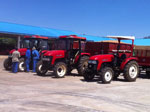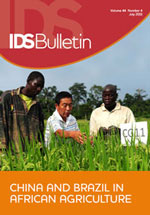Much recent work on ‘the BRICS in Africa’ has emphasised the geopolitical scale, as these new players engage in areas dominated in the past by western donors and companies. However, as the IDS Bulletin shows, the countries grouped together under the generic BRICS label have very different interests and priorities, and within these countries there are battles between different approaches, reflecting domestic political debates.
Brazil in Mozambique
One example of so-called south-south development co-operation is Brazil’s efforts to support agricultural development and food security in Africa. ProSavana, perhaps the most ambitious and high-profile initiative, is expected to cover 14 million hectares of land along the Nacala corridor, an area spreading across three provinces of northern Mozambique, to reshape the region’s economic landscape and transform it into a highly productive region. More than 100 farmers, especially from the Brazilian state of Mato Grosso, are reported to have visited Mozambique in recent years. ProSavana has provoked strong reactions in Mozambique – praised by some as a way of replicating Brazilian success, and criticised by others as a top-down initiative which fails to include farmers and civil society and may drive people off the land.
But Brazil’s own history is more complex than that demonstrated by ProSavana and other large-scale initiatives: family farms, landless farmers and minority communities struggling for land rights, agro-ecological alternatives and interactions and confrontations between government and society are also part of the story.
China and agricultural technology
 In 2006, Chinese President Hu Jintao announced the establishment of ten Agricultural Technology Demonstration Centres (ATDC) across Africa, as part of moves to consolidate China-Africa partnerships. In Zimbabwe, the US$30 million ATDC Centre is designed to showcase Chinese successes in technology and methods of production, provide training and conduct research. The Centre is a donation from the Chinese government and was established as part of the commitments made by China to Africa from the 2006 Forum on China-Africa Cooperation (FOCAC) conference and reiterated at subsequent such gatherings. The inclusion of the ATDC as part of the aid programme with China could challenge the perception that Chinese technology is inferior to that of the West.
In 2006, Chinese President Hu Jintao announced the establishment of ten Agricultural Technology Demonstration Centres (ATDC) across Africa, as part of moves to consolidate China-Africa partnerships. In Zimbabwe, the US$30 million ATDC Centre is designed to showcase Chinese successes in technology and methods of production, provide training and conduct research. The Centre is a donation from the Chinese government and was established as part of the commitments made by China to Africa from the 2006 Forum on China-Africa Cooperation (FOCAC) conference and reiterated at subsequent such gatherings. The inclusion of the ATDC as part of the aid programme with China could challenge the perception that Chinese technology is inferior to that of the West.
Aside from technology transfer, China is also engaged in contract farming arrangements in the country. These have become a more significant way to fund agriculture in Zimbabwe as traditional sources of funds have become less able to do so. In 2012, China maintained its position as the top buyer of Zimbabwe’s tobacco, and is also strongly involved in the cotton industry. The strengthened relationships with China and Brazil have been important to Zimbabwe during a period of relative isolation and sanctions from the West.
Opening up the development game
In many respects the arrival of new players on the scene in Africa has opened up the development game. The old, narrow conditions no longer apply, and African governments do not need to be constrained by the rules of Western development aid. With new players, carrying with them different discourses and practices rooted in their own recent development experiences, the room for manoeuvre by African states may be increased.
 Yet engagement always comes with strings attached, despite the warm-sounding rhetoric of ‘South-South cooperation’, ‘mutual benefit’ and ‘political solidarity’. China and Brazil need Africa, just as Africa needs them. Africa’s resources, including its land, are critical both for longer-term global food security, particularly in the populous parts of Asia, and such low cost resources, labour and market connections are vital for agribusiness and trade plans.
Yet engagement always comes with strings attached, despite the warm-sounding rhetoric of ‘South-South cooperation’, ‘mutual benefit’ and ‘political solidarity’. China and Brazil need Africa, just as Africa needs them. Africa’s resources, including its land, are critical both for longer-term global food security, particularly in the populous parts of Asia, and such low cost resources, labour and market connections are vital for agribusiness and trade plans.
From the colonial era and through post-colonial development, African policymakers and technical experts have learned to negotiate around technology transfer, economic reform or loan agreements. ‘Africa’ has not just been a passive recipient in many of these cases.
But the range of choice presents dilemmas. Should Mozambique, say, go down the route of smallholder agricultural production, and low input agriculture, promoted by many western donors and NGOs? Or should it aim for large-scale commercial, mechanised agriculture, modelled on the Brazilian Cerrado experience, or the large farms of northern China?
To understand the new encounters in development cooperation brought by the BRICS and others, we have to get to grips with the details, and the cultural, social and political relations at play, as well as the wider political economy that structures such engagements. Whose interests are being served? Who wins and who loses? These questions will be keenly watched as Africa’s farmers, food producers and politicians look to partners in the South for a new future.
Read more
 IDS Bulletin (44.4): China and Brazil in African Agriculture
IDS Bulletin (44.4): China and Brazil in African Agriculture
edited by Ian Scoones, Lidia Cabral and Henry Tugendhat
July 2013There is currently much talk of the role of the ‘rising powers’ in Africa, and whether their engagements represent a ‘new paradigm’ in development cooperation. This IDS Bulletin examines Brazilian and Chinese agricultural development cooperation in Africa focusing on different financial modalities, practices and politics of engagement, the ‘encounters’ that occur during negotiations, and the intersection of widerframing discourses with practices on the ground.
- Project: China and Brazil in African Agriculture
